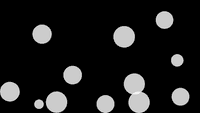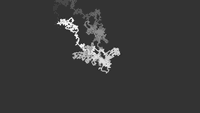Examples+
Non-orthogonal Collision with Multiple Ground Segments
by Ira Greenberg
Based on Keith Peter's Solution in Foundation Actionscript Animation: Making Things Move!
Highlighted Features
/**
* Non-orthogonal Collision with Multiple Ground Segments
* by Ira Greenberg.
*
* Based on Keith Peter's Solution in
* Foundation Actionscript Animation: Making Things Move!
*/
Orb orb;
PVector gravity = new PVector(0,0.05);
// The ground is an array of "Ground" objects
int segments = 40;
Ground[] ground = new Ground[segments];
void setup(){
size(640, 360);
// An orb object that will fall and bounce around
orb = new Orb(50, 50, 3);
// Calculate ground peak heights
float[] peakHeights = new float[segments+1];
for (int i=0; i<peakHeights.length; i++){
peakHeights[i] = random(height-40, height-30);
}
/* Float value required for segment width (segs)
calculations so the ground spans the entire
display window, regardless of segment number. */
float segs = segments;
for (int i=0; i<segments; i++){
ground[i] = new Ground(width/segs*i, peakHeights[i], width/segs*(i+1), peakHeights[i+1]);
}
}
void draw(){
// Background
noStroke();
fill(0, 15);
rect(0, 0, width, height);
// Move and display the orb
orb.move();
orb.display();
// Check walls
orb.checkWallCollision();
// Check against all the ground segments
for (int i=0; i<segments; i++){
orb.checkGroundCollision(ground[i]);
}
// Draw ground
fill(127);
beginShape();
for (int i=0; i<segments; i++){
vertex(ground[i].x1, ground[i].y1);
vertex(ground[i].x2, ground[i].y2);
}
vertex(ground[segments-1].x2, height);
vertex(ground[0].x1, height);
endShape(CLOSE);
}
class Ground {
float x1, y1, x2, y2;
float x, y, len, rot;
// Constructor
Ground(float x1, float y1, float x2, float y2) {
this.x1 = x1;
this.y1 = y1;
this.x2 = x2;
this.y2 = y2;
x = (x1+x2)/2;
y = (y1+y2)/2;
len = dist(x1, y1, x2, y2);
rot = atan2((y2-y1), (x2-x1));
}
}
class Orb {
// Orb has positio and velocity
PVector position;
PVector velocity;
float r;
// A damping of 80% slows it down when it hits the ground
float damping = 0.8;
Orb(float x, float y, float r_) {
position = new PVector(x, y);
velocity = new PVector(.5, 0);
r = r_;
}
void move() {
// Move orb
velocity.add(gravity);
position.add(velocity);
}
void display() {
// Draw orb
noStroke();
fill(200);
ellipse(position.x, position.y, r*2, r*2);
}
// Check boundaries of window
void checkWallCollision() {
if (position.x > width-r) {
position.x = width-r;
velocity.x *= -damping;
}
else if (position.x < r) {
position.x = r;
velocity.x *= -damping;
}
}
void checkGroundCollision(Ground groundSegment) {
// Get difference between orb and ground
float deltaX = position.x - groundSegment.x;
float deltaY = position.y - groundSegment.y;
// Precalculate trig values
float cosine = cos(groundSegment.rot);
float sine = sin(groundSegment.rot);
/* Rotate ground and velocity to allow
orthogonal collision calculations */
float groundXTemp = cosine * deltaX + sine * deltaY;
float groundYTemp = cosine * deltaY - sine * deltaX;
float velocityXTemp = cosine * velocity.x + sine * velocity.y;
float velocityYTemp = cosine * velocity.y - sine * velocity.x;
/* Ground collision - check for surface
collision and also that orb is within
left/rights bounds of ground segment */
if (groundYTemp > -r &&
position.x > groundSegment.x1 &&
position.x < groundSegment.x2 ) {
// keep orb from going into ground
groundYTemp = -r;
// bounce and slow down orb
velocityYTemp *= -1.0;
velocityYTemp *= damping;
}
// Reset ground, velocity and orb
deltaX = cosine * groundXTemp - sine * groundYTemp;
deltaY = cosine * groundYTemp + sine * groundXTemp;
velocity.x = cosine * velocityXTemp - sine * velocityYTemp;
velocity.y = cosine * velocityYTemp + sine * velocityXTemp;
position.x = groundSegment.x + deltaX;
position.y = groundSegment.y + deltaY;
}
}
Related Examples
This example is for Processing 4+. If you have a previous version, use the examples included with your software. If you see any errors or have suggestions, please let us know.





